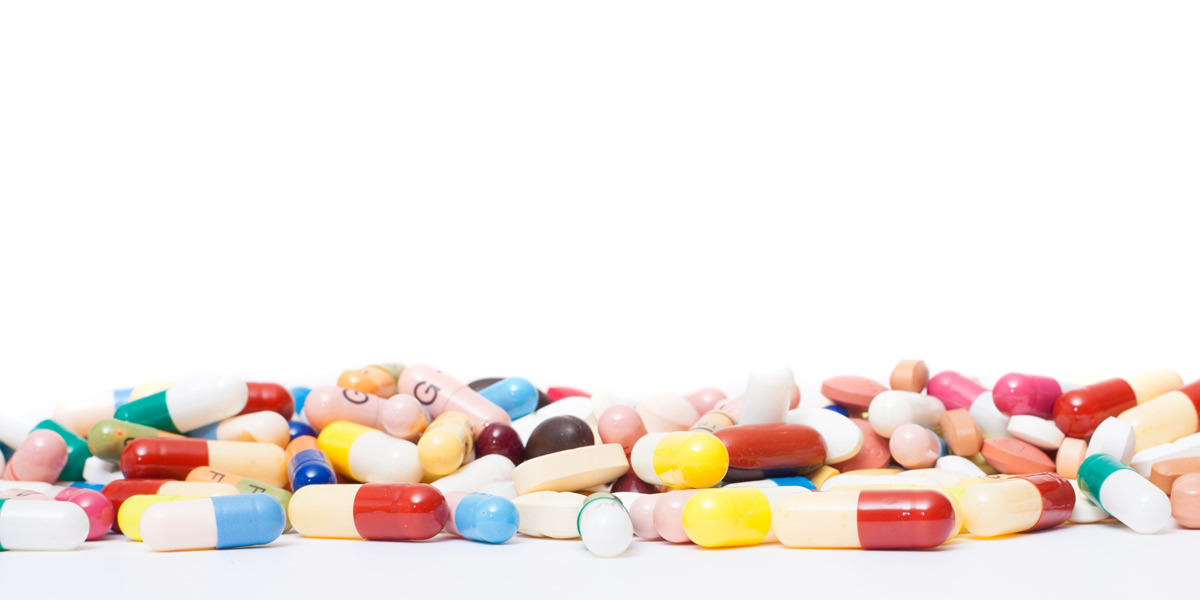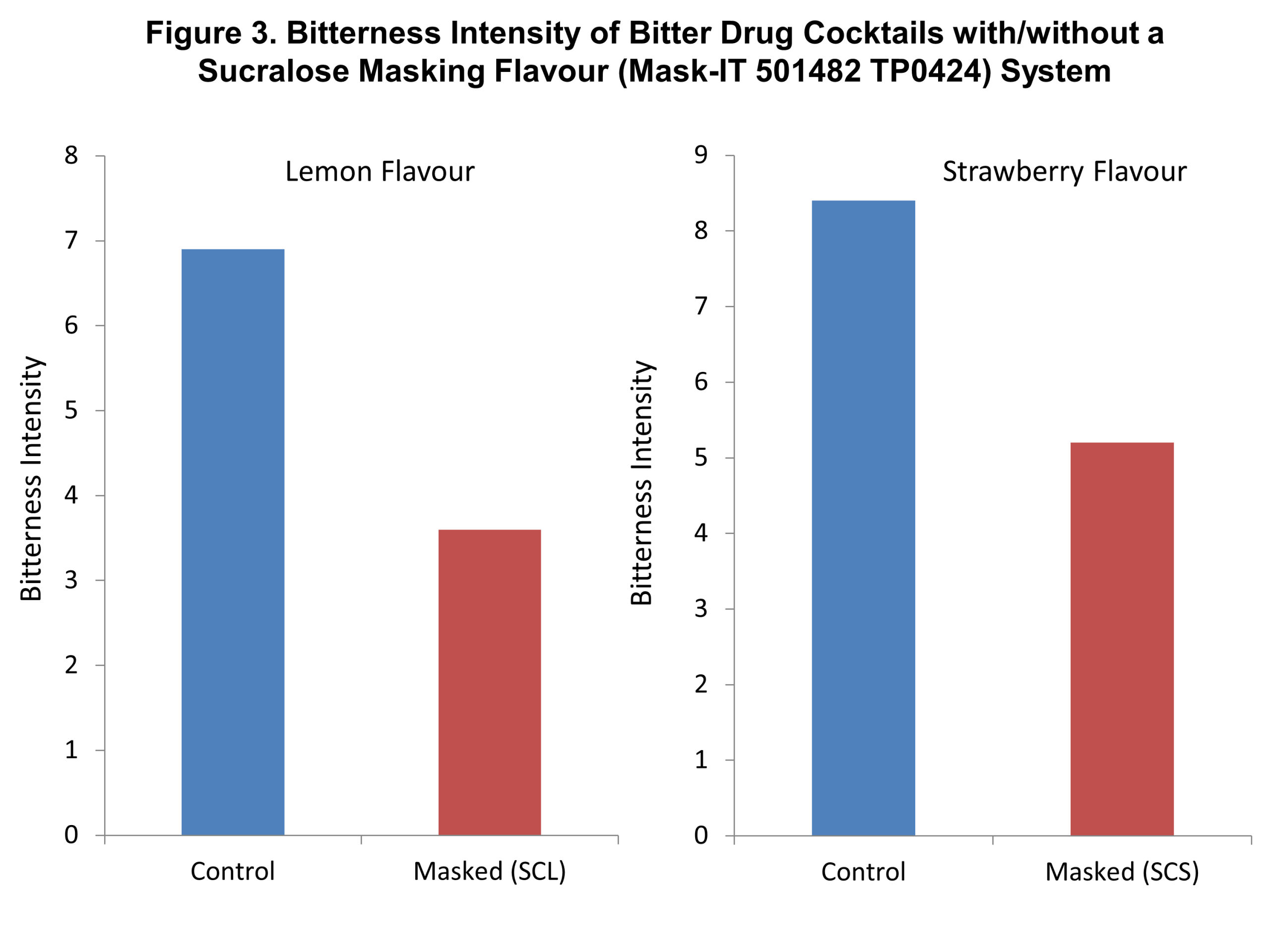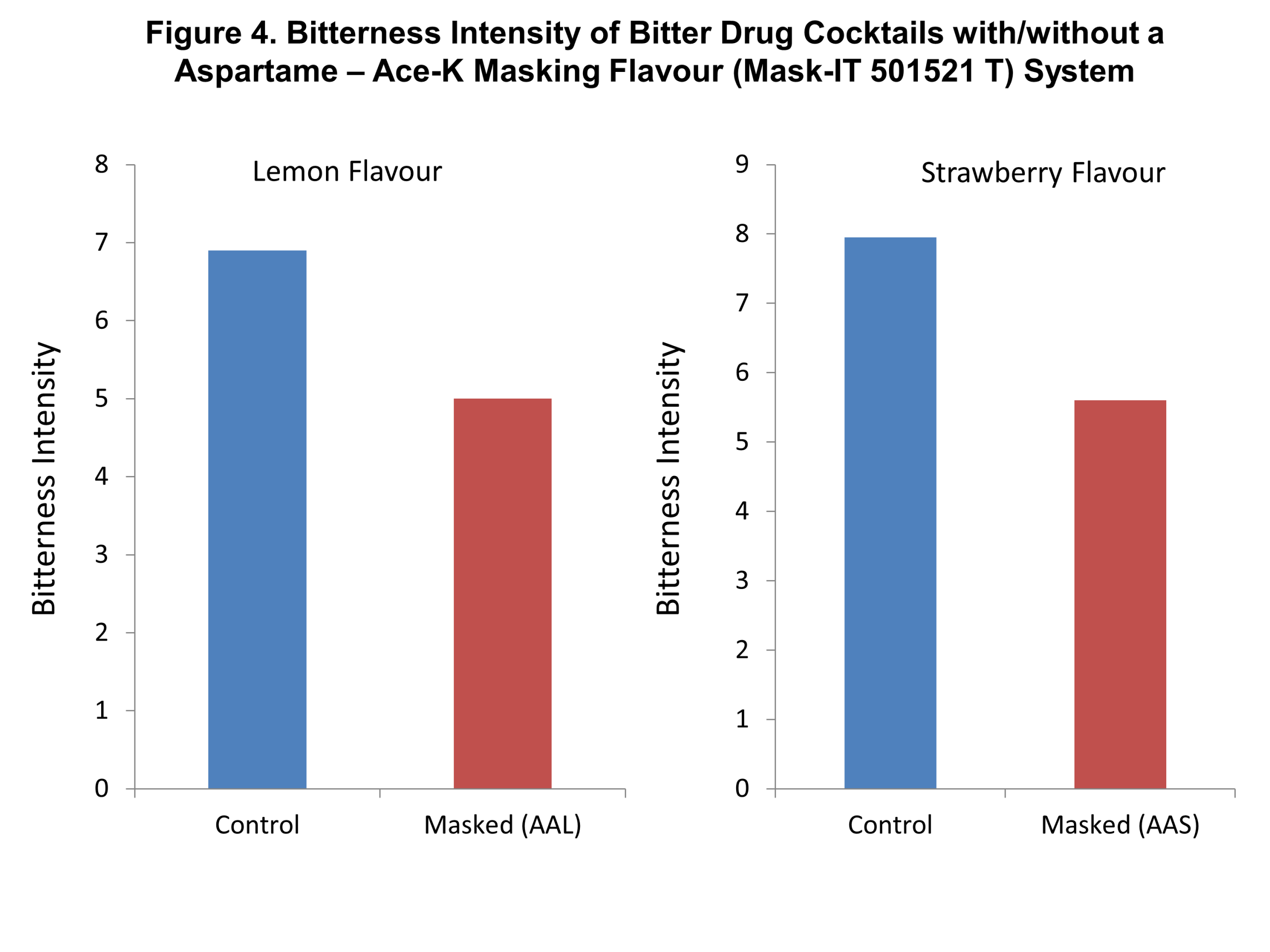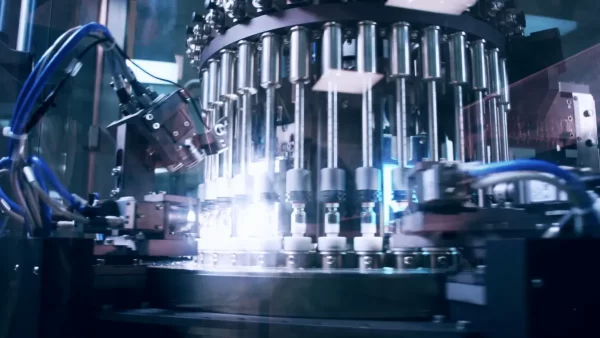By Cecile Guillon and Philippe Lepinay
Quest Pharma
Abstract
The effectiveness of two commercial masking flavours to conceal bitterness of a drug cocktail made of paracetamol, caffeine, and quinine was investigated. Using a panel of 20 trained panellists it was found that masked solutions achieved a 28% reduction in bitterness perception using an Aspartame – Acesulfame potassium masking system flavoured with lemon and strawberry flavours. When the same solutions were masked with a sucralose-based masking system, the reduction in bitterness intensity was 47% for lemon flavour and 38% for strawberry flavour. This study demonstrates the effectiveness of using masking technologies in reducing bitterness intensity, however care must be taken to select a complimentary flavour for even higher effectiveness.
Introduction
Among the five basic tastes, bitterness is perceived by humans as the most unpleasant, and is therefore of commercial and clinical importance for pharmaceutical products(1). Creating palatable products, in which aversive sensory attributes have been reduced, is of utmost importance.
The traditional approach to countering bitter tastes is through the use of sweeteners, flavours and other excipients carefully selected and combined in a manner which permits each ingredient to contribute complimentary attributes to the formulation. The goal is to achieve a neutral base taste, which can then be appropriately flavoured.
Sweeteners are used since being very soluble, they quickly dissolve in saliva and coat the taste buds, thwarting the interaction of bitter active substance with taste buds. However, there is a limit to the use of sweeteners. For instance, for overwhelmingly bitter actives, it is not always feasible to use large quantities of sweeteners to overwhelm such intensely bitter actives.
There is also the often overlooked issue of bitterness perception kinetics. Sweeteners such as sucrose have a fairly rapid onset of action and quickly fade away whereas most bitter chemicals linger on for a while in the mouth. Thus, even formulations containing sucrose may require the addition of specific flavour chemicals interacting with bitter receptors with a long temporal profile.
A different approach is to use compounds that compete with the bitter drug for binding with the bitter receptor on the tongue. When carefully formulated, these materials may have the effect of decreasing the perception of bitterness.
The aim of this study was to assess the effectiveness of two commercial masking flavour technologies to reduce the perception of bitterness (bitterness intensity) of drug cocktail made of paracetamol, caffeine, and quinine. To minimise grittiness and mouthfeel effects, the drug solution was suspended in a 0.05% w/w Gellan gum fluid gel.
Materials and Methods
Drug cocktail preparation
A simple cocktail of well-known bitter active pharmaceutical ingredients (quinine hydrochloride, paracetamol and caffeine) was prepared using commercially-available lemon or strawberry flavours. The drug cocktails were then masked with either an Acesulfame/Aspartame K-based masking flavour system or a sucralose-based masking flavour system in accordance with the manufacturer’s recommendations (Table 1).
Fluid gel preparation
The fluid gel was prepared following the bill of quantities shown in Table II.
 The required quantities of Gellan gum was added to water and heated to 85 oC with moderate stirring. Once fully hydrated, sodium citrate was added and stirring continued. The mixture was then allowed to cool to 56 oC to form a gel. Anhydrous citric acid was added and the mixture gently sheared form a fluid gel.
The required quantities of Gellan gum was added to water and heated to 85 oC with moderate stirring. Once fully hydrated, sodium citrate was added and stirring continued. The mixture was then allowed to cool to 56 oC to form a gel. Anhydrous citric acid was added and the mixture gently sheared form a fluid gel.
The fluid gels were further characterised rheologically with the aid of a commercial theometer (Anton Paar MCR 300, Anton Paar, Graz, Austraia) using a concentric cylinder geometry. Steady state shear flow tests were used to measure viscosity and shear stress. The results are shown in Figure 2.
Sensory protocol for masking evaluation
Twenty trained panellists ranked the bitter intensity of the four solutions on a 0-10 linear scale. Each series were evaluated on separate days. Within each series, a blind balanced presentation order was used to avoid order effect. Acquisition and statistical analysis of the sensory results were performed using Fizz v.2.0 (F-Biosystemes) software.
Results and Discussion
Sensory performance of masking flavours
The traditional approach for masking bitterness uses a flavour associated with bitterness (e.g. lemon or grapefruit) in order to trick the brain to dissociate the bitterness from the taste of the base to that of the flavour. However, using red fruit flavours (e.g strawberry) which are associated with sweetness, makes consumer to link the bitterness with the base and not with the fruit flavour, which reduces the overall acceptability of the final product. This is the reason the performance of the masking flavours were assessed using two opposite flavour tonalities that exhibit opposite bitterness tolerances: lemon and strawberry.
Sucralose based masking flavors
The bitterness perceptions by 20 trained panellists of the two solutions (control, masked) are indicated in Figure 3.
The profiles of both samples were not modified by the addition of the masking flavours. Results clearly indicate a 47% and 38% reduction in bitterness perception for the lemon and strawberry flavoured samples with a high level of statistical significance.
Aspartame/Acesulfame K based masking flavours
The bitterness perceptions by 20 trained panellists of the two solutions (reference and masked) are indicated in Figure 4.
Results clearly indicate a 28% reduction in bitterness perception with a high level of statistical significance. The profile of the lemon was not modified by the addition of the masking flavour.
The panel described the sample as milder and sweeter than the reference. Similar benefits were observed in the strawberry flavoured product, where results indicate a 30% reduction in bitterness perception. The profile of the strawberry was only slightly modified by the addition of the masking flavour (sweeter, more caramelic).
Conclusion
Masking flavours can efficiently reduce bitterness intensity in very bitter drug cocktails made of paracetamol, caffeine, and quinine.
References
Walsh J, Cram A, Woertz K, Breitkreutz J, Winzenburg G, Turner R, Tuleu C; European Formulation Initiative. Playing hide and seek with poorly tasting paediatric medicines: do not forget the excipients. Adv Drug Deliv Rev. 2014 Jun;73:14-33. doi: 10.1016/j.addr.2014.02.012. Epub 2014 Mar 12. PMID: 24614069.
CITATION:
When referring to this article, please cite as: C. Guillon and P. Lepinay, The sensory performance of masking flavours in bitter drug cocktails. Pharmacentral Science and Technology Bulletin 01 (09) 2021.











